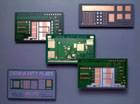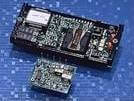Home


Outline
A highly thermally conductive insulated metal substrate (IMS) consisting of an aluminum base, an epoxy-based insulation layer with a high inorganic content filler demonstrating high thermal conductivity, and a conductive foil, thereby realizing thermal resistance equivalent to, or less than that of an alumina ceramic substrate.
Characteristics
- High thermal conductivity (a ;line up with maximum conductivity of 8W/mK)
- High reliability (voltage resistance, heat resistance, and heat shock resistance and durability)
In the field of power hybrid ICs, progress is being made every day in terms of miniaturization, higher degree of integration and higher power. These substrates require a higher degree of heat dissipation as well as higher reliability and processing power than their predecessors. DENKA has released a series of high thermal-conductivity materials such as “DENKA THERMALLY CONDUCTIVE SHEET” from this very standpoint.
“DENKA HITT PLATE” is a metal circuit board with high thermal conductivity, which DENKA has developed using our high thermal-conductivity technologies, consisting of an aluminum base, an epoxy-based insulation layer with a high inorganic content filler demonstrating high thermal conductivity, and a conductive foil, thereby realizing thermal resistance equivalent to, or less than that of an alumina ceramic substrate.
They are used in a wide variety of applications, including air conditioner inverters, stereo amplifiers, automobile and motorcycle electrical devices, and power supplies for communications equipment.
Applications
- Industrial electronic equipment (transistors and diode modules, step and servo motors, SSRs, etc.)
- Automotive electrical components (power driven power steering controller, inverter for (H)EV, etc.)
- Power supply (AC-DC converter for telecommunications, OA, semiconductor equipment)
- Home appliances (hi-fi amplifiers, inverters for air conditioners, etc.)
- Others (PDPs, LEDs and many other)
Constitution
Cu foil, Insulation thermal conductive layer, A1 base

Features
General characteristics of thermally conductive dielectreic layer (representative values)
Thermal conductivity (W/m•K), Volume resistivity (Ω•cm) at 23oC, Coefficient of thermal expansion (oC -1), Young’s modulus (N/m2), Poisson’s ratio, Glass transition point (oC)
General purpose type K-1, High heat resistance, high thermal conductivity type TH-1, Ultra-high thermal conductivity type, High solder-crack resistance type (EL-1)

